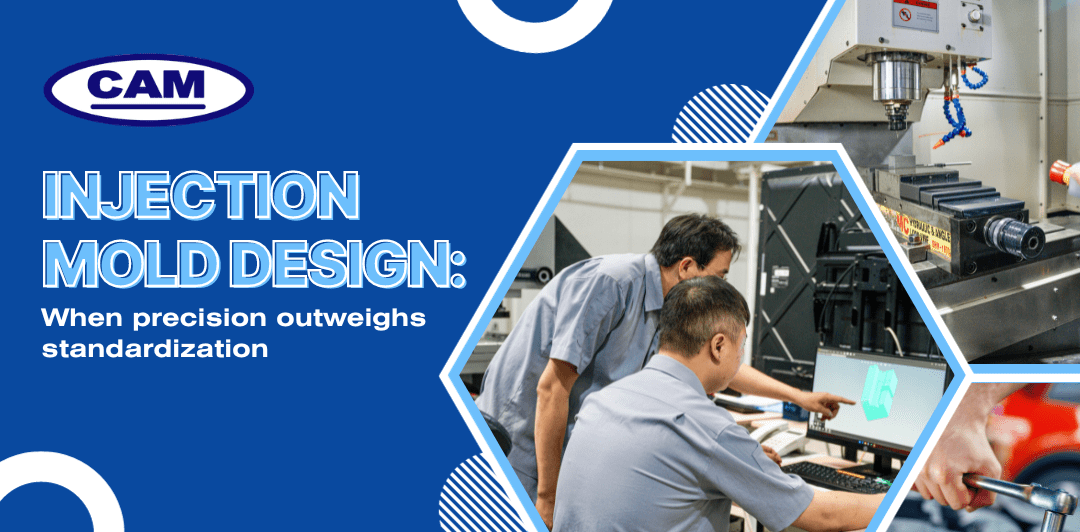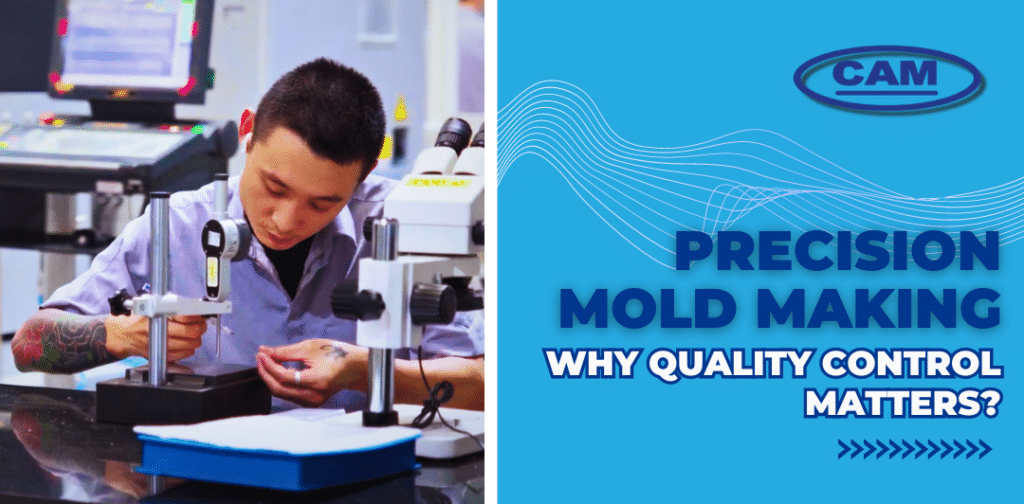In the world of mold manufacturing, countless decisions are to be made that directly impact the quality of the final product intended for mass production. Choosing between precision and standardization on the mold design could be a challenge and it comes down to the precision engineers and technicians for making a wise call.

We all like to experiment and explore potential options, and A/B testing is a great way to see what works best when we are confronted with two distinct options, each with its unique attributes. Regardless of industries and fields, we face such scenarios, where crucial decisions are to be made.
Similarly, in the realm of plastic injection molding, the choice between precision and standardization in “mold design” is not a black-and-white decision. Standardization helps with repeatability and sets a defined protocol for the mold design and production process, whilst precision is about going the extra mile for absolute accuracy and the tightest tolerance.

Both the standardization and precision approaches have remarkable advantages, but before deciding, one has to have a solid understanding of injection mold design and the consequences, given the fact that the molds are meant for mass-producing plastic parts that fit the puzzle with no flaws. In this blog article, we will explore the advantages of both approaches and examine their respective merits in specific scenarios.
Understanding Injection Mold Design
Injection mold design process entails creating a detailed layout for a mold that is built for the purpose of plastic injection molding. It involves designing the mold cavity, core, and other components to accurately replicate the desired shape of the final product. The design takes into consideration factors such as part geometry, material flow, cooling channels, and ejection mechanisms.
The main objective of injection mold design is to ensure the efficient and effective production of high-quality parts. A well-designed mold enables proper material flow, filling the mold cavity uniformly and minimizing defects such as air traps, sink marks, or warpage. It also includes the design of cooling channels, which help dissipate heat and reduce cycle time.

Injection mold design involves using computer-aided design (CAD) software to create a 3D model of the mold. This allows designers to visualize and analyze the mold design, making necessary adjustments before moving forward with fabrication. After being designed by CAD Software, the model will proceed to be converted to CAM for the suitable format for the machining process. This transfer is a significant step in the precision machining process. In conclusion, the precision and accuracy of the mold design are crucial to achieve tight tolerances and maintain consistency in part dimensions.
Standardization and its Advantages:
Standardization in precision mold design is an aspect that involves implementing a set of standardized guidelines and practices to ensure top-notch quality. It’s like having a rulebook that defines common parameters, dimensions, tolerances, materials, and manufacturing processes. By adhering to these standards, designers can streamline the entire mold design process, minimize errors, and enhance overall efficiency. Additionally, standardization promotes component interchangeability and cost-effective manufacturing. So, think of it as one of the recipes for success in creating precision molds!

While precision plays a crucial role in injection mold design, standardization also offers numerous benefits. By utilizing standardized mold components, manufacturers can reduce costs, increase efficiency, and improve interchangeability. Standardization involves using pre-designed components that are readily available and easily interchangeable. This eliminates the need for custom-made components, which can be expensive and time-consuming to produce.
Standardized mold components also offer faster production cycles. Since the components are readily available, the mold can be assembled quickly, reducing lead times and improving overall productivity. This is particularly beneficial for high-volume production runs, where time is of the essence, yet it comes with greater flexibility for producing parts with varying geometries or dimensions.
Why Precision is Crucial for Injection Mold?
Precision on the other hand in context to injection mold design is critical for achieving consistent and accurate results. This is particularly important when producing complex parts with tight tolerances and intricate geometries.
Precision plays a crucial role in ensuring that the mold accurately replicates the desired part geometry, resulting in parts that meet the required specifications. Any deviation from the intended dimensions can lead to defects such as warpage, sink marks, or flash, which can affect the quality of the final product.

Achieving precision in injection mold design requires attention to detail at every stage of the process. However, the manufacturer thoroughly understands the requirements of the product. This includes considering factors such as part geometry, material properties, and production volume. By understanding these requirements, the design can be tailored to meet specific needs, ensuring optimal functionality and performance.
When Precision Outweighs Standardization
Despite the advantages of standardization, there are scenarios where precision takes precedence over standard mold components. While standardized components offer cost savings, faster production cycles, and interchangeability, there are situations where customization and fine-tuning are necessary to meet specific product requirements.
Unique Geometries
Custom-designed components are critical for manufacturing, especially when it comes to producing products with complex shapes or tight tolerances. Standard mold components may not always be sufficient to achieve the desired results in such cases. This is where customization comes into play, offering manufacturers the opportunity to have greater control over the design and tailor the mold to meet specific product requirements.
By opting for custom-designed components, manufacturers can overcome the limitations of standard molds and create products that demand intricate shapes or precise tolerances. These components are specifically engineered to address the unique needs of each product, ensuring a perfect fit and optimal performance.

The process of creating custom-designed components involves careful analysis and collaboration between manufacturers and mold designers. It starts with a comprehensive assessment of the product’s specifications, including its shape, size, and functional requirements. Based on this analysis, mold designers work closely with manufacturers to develop a design that not only meets the product’s requirements but also takes into account factors such as material selection, manufacturing processes, and cost-effectiveness.
One of the key advantages of custom-designed components is the ability to achieve tight tolerances. This is particularly important in industries such as aerospace, automotive, and medical, where precision is paramount. By customizing the mold components, manufacturers can ensure that the final product meets the required specifications with minimal deviation.
High-performance Manufacturing
Another scenario where precision outweighs standardization is when producing high-value products. These products demand the highest level of accuracy and functionality, leaving no room for errors. Standard mold components may not be able to meet the stringent requirements of these products, making custom-designed components a necessity.
High-value products, such as advanced medical devices, aerospace components, or luxury goods, often have intricate designs and complex functionalities. Achieving the desired level of precision in manufacturing these products requires custom-designed components that can accommodate the specific design intricacies and tolerances.

By opting for custom-designed components, manufacturers can ensure that each part of the product is precisely manufactured to meet the exact specifications. This level of precision is crucial for guaranteeing optimal functionality, performance, and reliability of high-value products, ultimately leading to customer satisfaction and market success.
Specialized Materials
Custom-designed components can be made from materials that are better suited for the product, ensuring optimal performance and longevity. Some products require materials that are not compatible with standard mold components, making customization a necessity.
For example, when manufacturing products that require high-temperature resistance or chemical resistance, standard mold components may not be able to withstand the harsh conditions. In such cases, custom-designed components made from specialized materials (Ex: Graphit, Titanium Carbide,…) can offer the required level of durability and performance.

Custom-designed components can be made from a wide range of materials besides the top 5 commonly used raw materials, including metals, plastics, composites, and ceramics. The choice of material depends on the specific product requirements, such as temperature resistance, chemical resistance, durability, and performance characteristics. Choosing specialized materials will present you with durability and tolrance to wear and tear, leading to reduced maintenance costs and enhanced product reliability.
Concluding, while standardization offers numerous advantages in injection mold design, there are scenarios where precision takes precedence. Customization allows for greater control over the design, enabling manufacturers to tailor the mold to meet specific product requirements. When producing high-value or high-performance products, precision is paramount to ensure optimal functionality and performance. In these cases, custom-designed components may be necessary to achieve the desired results.
Striking the Right Balance
Finding the right balance between precision and standardization is key to optimizing injection mold design. Striking a balance that maximizes efficiency, quality, and cost-effectiveness is crucial for manufacturers to remain competitive in today’s market.
Using a Modular Mold Design
Modular molds are designed with standardized components that can be easily interchanged to accommodate different product designs. This approach allows manufacturers to achieve precision in critical areas while maintaining standardization in other areas, leading to cost savings and improved efficiency.

Modular mold designs offer several advantages over traditional custom-designed molds. They allow manufacturers to quickly adapt to changing product designs and market demands, leading to enhanced agility and responsiveness. Moreover, modular molds are often more cost-effective than traditional custom-designed molds, making them an attractive option for manufacturers looking to optimize their production processes.
Advanced Simulation Software
Simulation software plays a crucial role in the manufacturing industry by offering manufacturers the ability to simulate and analyze various mold designs and configurations before proceeding with actual production. This technology empowers manufacturers to identify potential issues and make necessary adjustments to optimize the design for maximum efficiency and quality.

One of the key advantages of using simulation software in the manufacturing process is the ability to achieve precision in critical areas. By simulating different mold designs, manufacturers can evaluate factors such as material flow, cooling rates, and part shrinkage. This allows them to make informed decisions about the optimal design parameters, ensuring that the final product meets all desired specifications.
Well-defined Manufacturing Protocol
Standardized processes are an essential component of efficient and high-quality manufacturing. By implementing standardized processes, manufacturers can ensure consistency in product quality and minimize the likelihood of errors or defects.
With standardized processes, manufacturers can establish clear guidelines and procedures that outline the steps to be taken at each stage of production. This promotes a systematic approach to manufacturing, reducing, the chances of variability or inconsistencies in the final product are significantly reduced.

In conclusion, finding the right balance between precision and standardization is crucial for optimizing injection mold design. Modular mold designs, advanced simulation software, and standardized manufacturing processes are all effective ways to strike this balance. By achieving precision in critical areas while maintaining standardization in other areas, manufacturers can enhance efficiency, quality, and cost-effectiveness, ultimately leading to greater success in today’s competitive market.
MAKING A SMARTER CHOICE:
In conclusion, injection mold design requires careful consideration of both precision and standardization. While standardization offers advantages in terms of cost and speed, precision becomes indispensable when intricate details and tight tolerances are necessary. By understanding the balance between these two factors, manufacturers can optimize their mold designs for superior results.
When it comes to precision tooling needs for your manufacturing, making the right choice is indeed critical essentially making the difference and at CAM Resources, we exactly understand it. We’ve build trust with customers worldwide coming from several industries including connectors, electronics, medical and automotive. Understanding the importance of precision, we are committed to helping our clients make informed decisions that lead to optimal results.
Contact us today to learn more about how we can help you in identifying solutions that meet your precision needs.
Minh Ngoc Truong
Hi, I'm Minh Ngoc, a dedicated blog writer and social media manager at CAM Resources.

